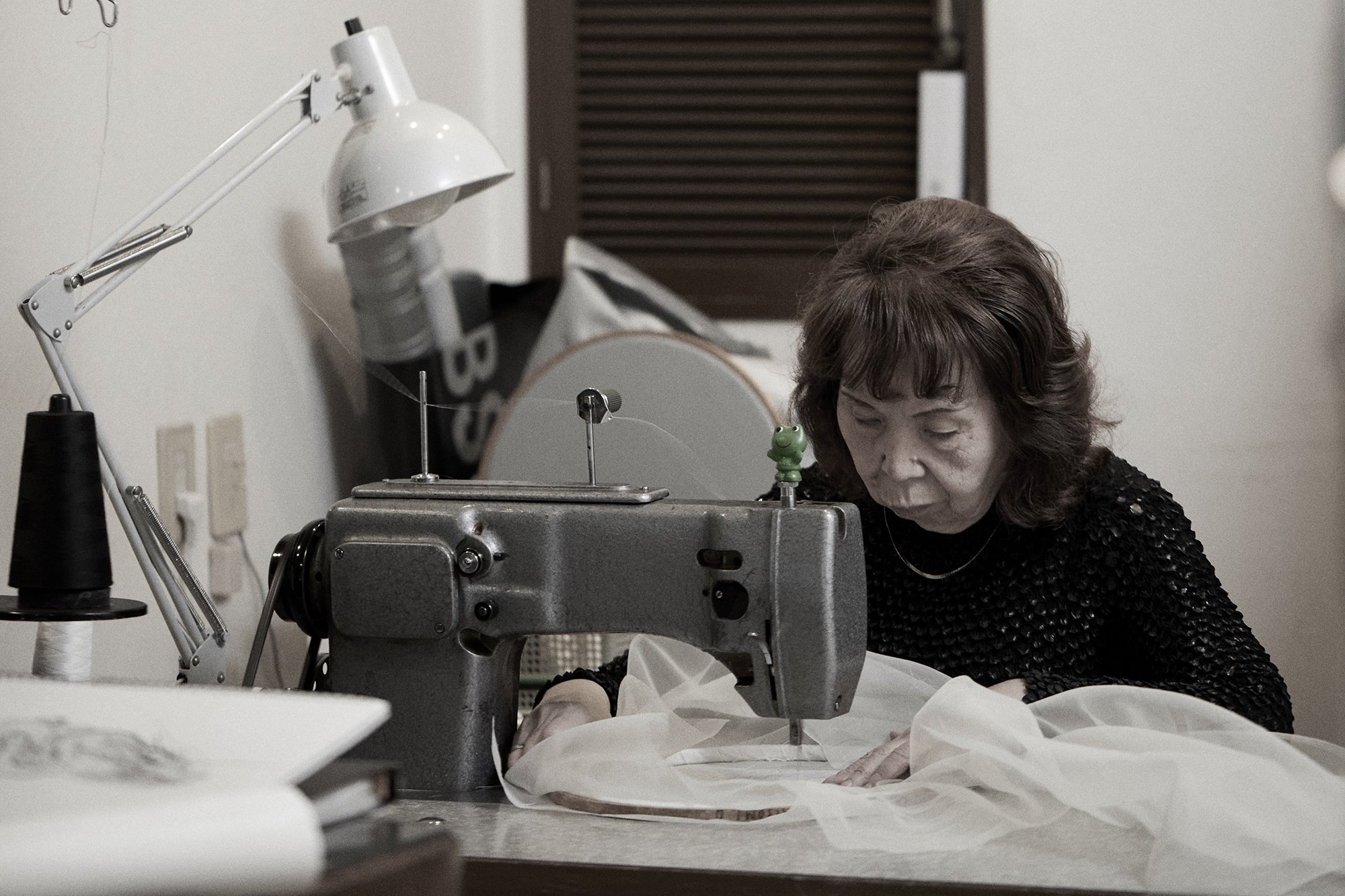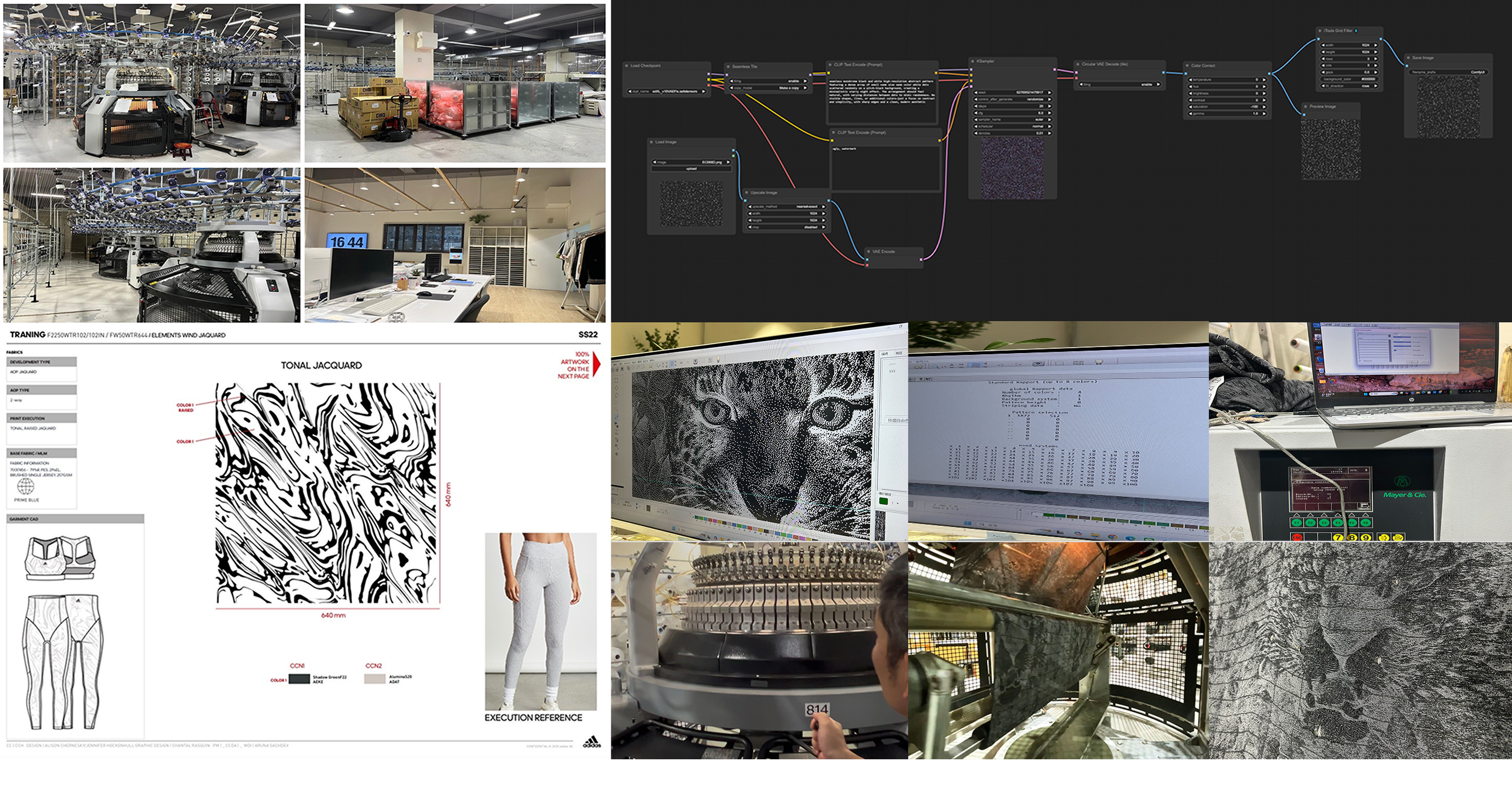Thread is paint, the needle a brush, and AI the canvas | Kiyomi Osawa
“I use not only hands and legs, but also ears to make embroidery ”
Despite losing half of her eyesight, Kiyomi Osawa continues her embroidery work, relying not only on sight but on touch and sound to create depth, 奥行き (okuyuki) in her work. Our AI model is also limited in its ability to perceive the world, through learning from Osawa-sensei we aim to explore ways AI too can understand depth.
“Why are individuals with such exceptional skills treated so poorly?”
Kiyomi Osawa
Trained as a painter, Kiyomi Osawa discovered a passion for Yokoburi embroidery at the age of 17 and swiftly rose to prominence thanks to her technical knowhow and artistry. However, she soon realized the stark inequalities in the industry—while company presidents gained wealth and recognition, the craftsmen behind the intricate embroidery were treated as mere technicians, underpaid and unacknowledged.
Determined to change this, Osawa-sensei challenged the status quo by making art and advocating for yokoburi craftsmen as artisans. Her collaboration with fashion designers such as Kansai Yamamoto and Yoshiyuki Konishi elevated the status of yokoburi embroidery. At age 70, she founded her company, Osawa Shokai, to ensure fair value is distribution to the artisans.
Kiyomi Osawa’s life’s work revolves around innovation and she is never afraid of adopting new technology. She is proud that the person who invented the yokoburi embroidery machine came from Kiryu.
Historical Innovation of Yokoburi Embroidery
Yokoburi (horizontal swing embroidery) emerged as a crucial innovation in Kiryu's embroidery industry. During the “Japanese Economic Miracle” in 1960s, demand for kimono grew and craftsmen struggled to keep up with orders through hand embroidery. To address this challenge, artisans began modifying sewing machines to perform embroidery, leading to the invention of the yokoburi embroidery machine.
At its peak, Kiryu had over 10,000 craftsmen engaged in yokoburi embroidery. However, as this mechanized technique advanced, a challenge arose: craftsmen operating the embroidery machines were no longer recognized as craftsmen but were instead treated as mere technicians. Their intricate work, once highly valued as a craft, was increasingly categorized as an industrial product.
Digitization Process
The first step in the project involved digitizing and processing of Kiyomi Osawa’s embroidery artworks. The digitization process was crucial in capturing the style of her needle painting technique, which blends color and texture seamlessly.
LoRA Model Training with Kohya_ss
To accurately replicate Kiyomi Osawa’s embroidery style in AI-generated images, we trained a Low-Rank Adaptation (LoRA) model using the Kohya_ss fine-tuning framework. This involved:
Compiling a high-quality dataset from digitized embroidery samples.
Tagging the training dataset using a WD14 Tagger.
Training a LoRA model based on these samples, ensuring output fidelity to Osawa sensei’s unique style.
Evaluating and refining the model through iterative testing and validation.
Stable Diffusion XL Integration via ComfyUI
The trained LoRA model was integrated with Stable Diffusion XL, using VAE Fix to maintain color accuracy and fine detail. This allowed us to generate high-resolution artworks that faithfully adhered to the original embroidery aesthetics.
Artisan-Centric UI
A custom UI wrapper was developed on top of ComfyUI to streamline the iterative process for the artisan to refine the generative AI model. Key features of the UI include:
Prompt-Based Input System – Simplified controls where artisans describe their desired output using natural language.
Artisan-Informed Controls – Custom parameters derived from artist’s voice in conjunction with AI’s voice, and number of iterations.
Open-Source Framework - Our technology is built on top of open-source frameworks ComfyUI, Kohya_SS and Flow.
On Machine Learning
Now that we have setup the basic framework for Kiyomi Osawa to work with the gen-AI, we have begun to focus on training the AI in these specific areas:
Needle Threading Technique – Training AI to recognize her threading technique that creates hyper realistic sense of texture and depth.
Machine Language Translation – Training AI to understand prompts that captures the emotional depth and intentionality of her creation.
Physical Fabrication – Training AI to translate digital embroidery onto physical textile using Mayer & Cie’s knitting machine.
Through this pilot, we aim to establish a new paradigm where traditional craftsmanship and AI coalesce, enabling artisans to extend their artistic expression while preserving cultural heritage in the digital age.
Access our growing collection of artworks, crafts, and exclusive products. Be invited to upcoming exhibitions, events, and artist collaborations (20% of your subscription goes directly into funding future artists' exhibitions)
We are grateful for the generous sponsorship from Fusheng Textile, as well as the mentorship and support from Koichi Saito and the Kiryu government officials. Thank you to the team behind ComfyUI, Kohya_SS and FlowUI for developing open-source tools and AI frameworks.
We would like to extend our heartfelt gratitude to Kiyomi Osawa and to the artisans of Osawa Shokai.
For more information, visit Osawa Shokai's website.

















